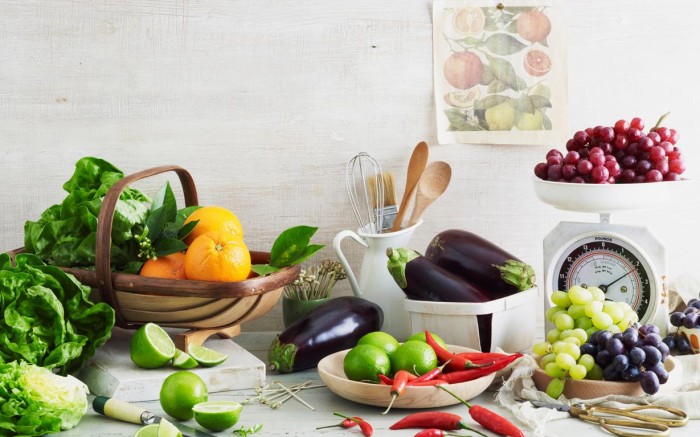10 Ways to Increase Your Fruit and Veggie Intake
1.) Buy more, eat more (veggies, that is)
Just like chips and cookies, the more fruits and veggies in particular you have in the house, the more likely you are to eat them. In other words, leave the bad stuff on the shelf and load the shopping cart with veggies and some fruits (my favorites being the berries). The less access you have to junk food, the more likely it is you’ll make a health-supporting choice when hunger or a late-night craving strikes.
2.) Change your approach
If you’re one of those people who has to fool themselves into eating more fruits and veggies, then make a game of it. Look at every meal or snack you eat and think about where you can sneak in an extra serving of fruits and veggies. Think salads are a bit of a snooze? Then wake ‘em up by tossing in almonds, walnuts, pine nuts, apples, pears, oranges or even some dried cranberries into your salads.
3.) Make cooking ridiculously easy
After shopping, wash and chop your just-bought raw or frozen veggies and store them in the fridge, preferably in glass or BPA-free containers. When it’s time to put a meal together you’ll be able to just grab your pre-prepped, salad-bar style veggies and toss ‘em right into whatever you’re cooking. The result? A much healthier meal with virtually no extra effort. Another bonus? With lots of ready-to-go veggies on hand, you’ll be able to eat perishables in a more timely fashion, so you’ll waste less food.
4.) Make it your way
One thing that I’ve found over the years is that the healthier one’s diet becomes, the less you eat out. The more attention you begin to pay to the quality of the ingredients and how healthfully the food is prepared, the less appealing restaurant dining becomes. Bottom line: You’ll save money and eat better by cooking at home most of the time. When it’s time to go out for a meal, be it a special occasion or treat at the end of a long week, boost the nutrition of your meal and customize it to your specifications by ordering extra vegetablesl.
5.) Breakfast in 60 seconds
If you have 60 seconds, you have time to blend up a healthy, fruit and fiber-packed breakfast. Reserve a few minutes over the weekend to pre-package your breakfasts for the week so you can move quickly on workday mornings. One of my patients assembles 5 days of smoothie ingredients into individual servings so in the morning all he has to do is grab a container, dump the contents into the blender, add water and press blend. Time elapsed: 1 minute, including blending!
6.) Drink your vegetables
Instead of buying processed, sugared veggie or fruit juices, experiment with whole fruits, veggies and nuts to see how many you can add to super-charge your fruit smoothies with nutrients. Among my favorite, easy-to-blend-in items: avocados, almonds, flax, chia seeds and nut butters, all of which add healthy fats, fiber and nutrients without overwhelming the fruity taste. If you prefer a greener, vegetable taste, either for a smoothie or a power juice, then spinach, powdered greens, mint, carrots, kale, watercress and broccoli are great gifts from the earth that blend beautifully. Another great alternative is a powdered greens drink which will usually contain the equivalent of three or four servings of fruits and vegetables.
7.) Make an eggsellent omelet
If you feel it’s just not breakfast without an egg in it, try going lighter on the eggs and heavy on the vegetables. To add nutrients and mass to your omelets, toss in steamed or lightly sautéed veggies like spinach, broccoli, tomatoes, peppers, mushrooms, zucchini, olives, onions, and garlic for a delicious breakfast that’s really worth eating. Another bonus of a veggie-packed omelet? A big-on-the-plate, hearty breakfast that’s nutrient dense and light on calories.
8.) Take your show on the road
When you leave the house in the morning, in addition to the usual phone-keys-wallet combo, add one more thing to your bag: snacks! A small container of walnuts, almonds, blueberries, cucumber slices, sliced jicama or carrot and celery sticks within arm’s reach will add another serving of fruit and veggies to your day. Better yet, it will help keep you away from the office vending machine. The BE WELL GREENS powdered drink in single serving packets is a great snack and perfect for people on the go. Just pour the packet into a glass, add water and you have an instant delicious (yes it is) vegetable juice.
9.) Cook creatively, dine differently
Update a traditional recipe by tossing as many extra veggies as you can into soups and sauces. Most extra veggies added towards the end of the cooking process won’t change the taste of a dish, so add with abandon. Throw them into a recipe that doesn’t usually include them. For example, add broccoli, mushrooms and cauliflower to a chicken curry or chopped spinach and flax seeds to spaghetti sauce.
10.) Leave room for dessert
A great dessert for instance is a bowl of mixed organic berries with a tablespoon or two of plain unsweetened sheep’s milk yoghurt (and a drizzle of raw honey if you want). It is easy to put together, satisfying and delicious.








